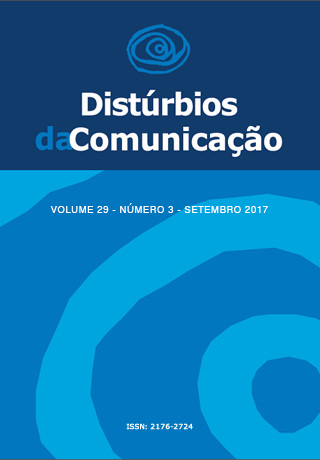Respiratory physiology during reading aloud tasks
DOI:
https://doi.org/10.23925/2176-2724.2017v29i3p519-528Keywords:
Phonation, Respiration, Biomechanical phenomena, Acoustic temporal measures, ElectromyographyAbstract
Objective: The purpose of this study was to determine the relation between speech utterance length and respiratory physiology. This experiment correlates respiratory kinematics, muscle activity and acoustic temporal measures of two utterance lengths read aloud tasks: phrase and sentence. Methods: 4 normal speakers read aloud 12 read phrases and 12 read sentences. Respiratory kinematics measures included lung volume excursion (LVE), rib cage excursion (RCE) and abdomen excursion (ABE). Respiratory muscle action included burst duration (BD) and peak amplitude (PA) of rectus abdominis (RA), pectoralis major (PM) and external oblique (EO) muscles. Acoustic temporal measures included phrase and sentence duration. For descriptive statistics means and standard deviations were used, and for inferential statistics Pearson correlation coefficient and Mann-Whitney Wilcoxon test were used. Results: All sentence mean values were greater than phrase and significance was achieved on duration, LVE and RCE means (p=.00). There was a positive correlation between duration, RCE and LVE measures (p=.00). There was a positive correlation between RCE and PA of PM and EO muscles (p=.00). Conclusions: To produce longer utterance tasks, RCE contributes greatly for the LVE needs. The RCE excursions are mostly supported by greater voluntary peak contractions of the PA and EO muscles rather than RA muscles.
Downloads
Downloads
Published
Issue
Section
License
Copyright (c) 2017 Ana Mendes, Lénia Ferreira, Ana Jorge, Howard Rothman, Daniela Tavares, Inês Garcez

This work is licensed under a Creative Commons Attribution 4.0 International License.









